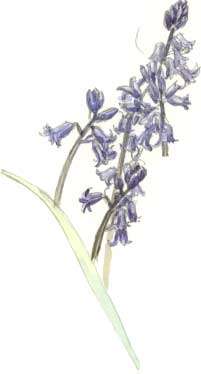BluebellsWednesday, 30th April 2003, West Yorkshire |
![]()
![]()
![]()
![]() Rocks | History |
Workshop |
Links | Home
Page
Rocks | History |
Workshop |
Links | Home
Page
![]()
 Twenty
years ago these bluebells were no more than a few plants
growing in the border by the hedge. They've spread to form a dense arc
of glossy green foliage four feet across with smaller colonies starting
along the bottom of the hedge along a twelve foot stretch and the odd
plant reaching the edge of the pond. They're almost growing like weeds
and it makes me realise that our garden, if left unattended for long enough,
would revert to woodland, merging into the bluebell woods of Coxley Valley
if human beings ever faded away from these parts.
Twenty
years ago these bluebells were no more than a few plants
growing in the border by the hedge. They've spread to form a dense arc
of glossy green foliage four feet across with smaller colonies starting
along the bottom of the hedge along a twelve foot stretch and the odd
plant reaching the edge of the pond. They're almost growing like weeds
and it makes me realise that our garden, if left unattended for long enough,
would revert to woodland, merging into the bluebell woods of Coxley Valley
if human beings ever faded away from these parts.
There's some concern that our English bluebells are being ousted in parts of the country by the Spanish variety which has been grow in gardens for many years but which is increasingly becoming established in the wild.
(Looking at the bluebells in the wood the next day I realised that our garden bluebells must be the Spanish variety. The flowers of our local wild bluebells are shaped more like sausages compared with these bell-like blooms).
 As
I'm painting there's a buzzing beside me. A large red-tailed bumblebee,
which I take from its size to be a queen, is investigating the lawn. For
many years in the middle of the lawn there has been a vole hole. The queen
flies down into it and emerges two minutes or more later. Perhaps she
is establishing a nest there.
As
I'm painting there's a buzzing beside me. A large red-tailed bumblebee,
which I take from its size to be a queen, is investigating the lawn. For
many years in the middle of the lawn there has been a vole hole. The queen
flies down into it and emerges two minutes or more later. Perhaps she
is establishing a nest there.
![]()
![]() Next page | Previous
page | This day in 2000
| This month | Nature
Diary | Home
Page
Next page | Previous
page | This day in 2000
| This month | Nature
Diary | Home
Page
![]()